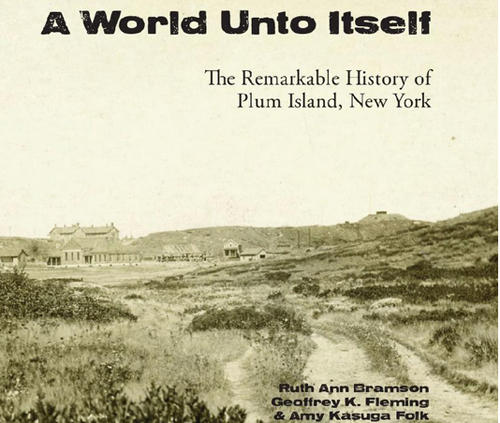Debunking Plum Island myths, for once and for all

Enough with the baloney.
That could have very well been the title of the Southold Historical Society’s latest nonfiction publication, called A World Unto Itself: The Remarkable History of Plum Island, New York.
The 388-page tome is being billed as “the definitive history” of the island off Orient Point.
In chronicling more than four centuries of history, its authors also sought to dispel decades’ worth of myths and conspiracy theories that have been perpetuated about the 1.3-square-mile island.
Once the home of a U.S. military installation called Fort Terry, which was built in the run-up to the Spanish-American War and was in service through World War II, Plum Island has since served as the home of a federally run animal disease research lab built in the mid-1950s.
Using a trove of primary source materials that included hundreds of photos and historic documents, the authors of the book — Ruth Ann Bramson, a retired university professor; society director Geoffrey K. Fleming; and collections manager Amy Kasuga Folk — found that, even with a place as mysterious as Plum Island, fact can still be stranger than fiction.
Even when that fiction includes tales of buried pirate treasure and rumors of experiments in bio-warfare.
Take, for instance, the 1914 court marshal of Fort Terry commander Major Benjamin Koehler, who was accused of sexually harassing soldiers at the camp. His conviction led to a revision of the Articles of War two years later, “to include sodomy as a felony, codifying, and effectively sanctioning, an attitude of intolerance and exclusion that would last for generations,” the book reads.
The questionable ruling led to the eventual “don’t ask, don’t tell” policy toward gays in the military until that policy’s 2010 repeal.
“This is supposed to be the true story,” Mr. Fleming said. “We’ve disputed the mythology and brought to light the real people and the real events that happened there.”
To further whet the appetite, here are some other little-known facts about Plum Island.
• An ownership dispute that persisted throughout the latter half of the 17th century — even Southold Town had laid stake to the island — was resolved in 1675 when Plum Island’s first European owner, Samuel Willis, was issued an ownership patent for the Manor of Plum Island. He claimed to have purchased the island from Indians of the Wyandank tribe.
The price amounted to “a coat, barrel of biskitt [and] 100 muxes, or fish hooks,” the book reads.
• The island’s last private owner was the wealthy industrialist Abram Hewitt, an iron manufacturer who had also served as a congressman, New York City mayor and longtime leader of the Democratic National Committee. He had planned to build a resort community on the island but later sold to the federal government. He sold the eastern side of the island — “150 acres more or less” — in 1887 for $25,000 and the remaining 647 acres in 1901 for $64,700, which likely included compensation for disputed acreage.
• Plum Island appears on European maps from as early as the 17th century. It’s generally accepted that the island was named after the beach plum bushes that were once abundant along its shores.
• President Grover Cleveland was a repeat visitor to Plum Island. He favored the area’s fishing and would typically arrive aboard Oneida, a 139-foot yacht owned by a wealthy friend. The Oneida played a starring role in a more famous event in presidential history. In 1893, President Cleveland concealed news of a malignant growth in his mouth, fearing a publicized illness would affect his ability to lead Congress in the middle of a fiscal crisis. Six surgeons operated on him in secret aboard the Oneida as it moved through Long Island Sound, removing parts of his jaw and hard palate. “The president recuperated for several days near Plum Island while his doctors, after making his prosthesis, went fishing in the Gut,” the book reads.
On its natural history, the book’s authors point to the largely undisturbed island as a rare glimpse of what the region looked like before humans settled, developed and industrialized such areas throughout the Northeast.
“At the same time, it bears the marks of the human history that has unfolded there,” reads a press release announcing the book’s publication, “the lighthouse tended by so many stalwarts; the narrow roads, rusted railroad tracks and overgrown artillery batteries once filled with soldiers who never saw combat; and, of course, the modern-day facility where the daily pursuit of science both moves us forward and pushes us away.”
The book is available at the society’s museum gift shop at $40 for the hardcover edition or $30 for the soft cover. Both editions are also available at amazon.com. For more information, visit the website, aworlduntoitself.com, or contact the Southold Historical Society at 765-5500.





